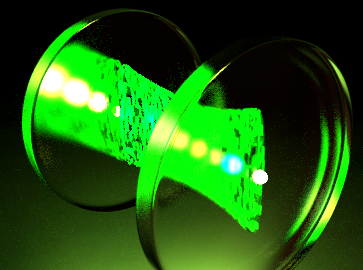B6N: Dimensional crossover in trapped photon gases
Axel Pelster, Frank Vewinger and Georg von Freymann
With a new experimental approach the properties of trapped photon gases are investigated within the crossover between one and two spatial dimensions. Here it is of special interest to achieve the first one-dimensional photon gas, where the one-dimensional geometry is realized by using a strongly asymmetric harmonic or box-like potential.
Varying the asymmetry allows us to study the influence of the "frozen" dimension on the properties of the one-dimensional gas. A special focus will be on the impact of the dye bath upon the equilibrium properties of the photon gas. While for atomic gases thermalization in one dimension is suppressed as the system is integrable, in our case thermalization proceeds via a molecular bath and correspondingly no integrability estrictions exist.
The technological base for the envisioned investigations is the possibility to imprint tailored potential landscapes by a particular coating of the cavity mirrors with photonic structures, using either phase-change chalcogenides like As2S3, or by imprinting polymer structures with 3d laser lithography.

Artist's view of the photon gas in an asymetric potential (T. Damm).
The experimental implementation of the one-dimensional photon gas and the crossover from one to two dimensions will be accompanied by a theoretical modelling to ensure that the technologically challenging production of the structures addresses the correct parameter ranges. To this end, both a mean-field description of the thermo-optic interaction in close analogyto the exciton-polariton condensates and a microscopic description of the Kerr interaction by extending the Kirton-Keeling model with respect to coherent terms based on a Lindblad master equation are available.
We will investigate how the potential asymmetry allows to define a superfluid density for open-dissipative photon gases. The resulting theoretical insight will then be applied to perform transport measurements with box-like potentials in order to determine, for instance, the superfluid density.

